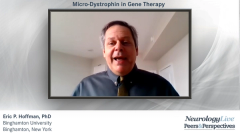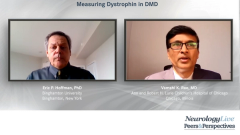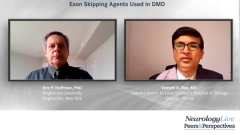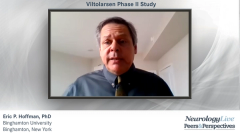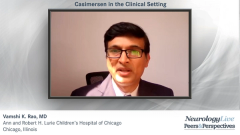
Early Treatment of DMD
Discussion on the importance of early treatment in patients with Duchenne muscular dystrophy.
Episodes in this series

Vamshi K. Rao, MD: As with anything in statistics, I absolutely agree that there are those 2 standard deviations and outliers, and our quest is always to look for a bell curve. There are 2 points you alluded to that I want to make sure we put front and center. One is the concept of variability and heterogeneity in terms of Duchenne muscular dystrophy as a disease. The other is the concept of normal vs abnormal dystrophin. These are very powerful concepts, not only now but as we think of further therapies.
In line with that, when I talk to patients in clinic about the clinical trials and research landscape, 1 thing that parents always ask me is, “What should I do? Should I wait for a new therapy in the future, or should I participate in something that’s in front of me right now?” It’s a very difficult situation for parents because they know their child is progressing. They see the changes. They may not see them day by day, but they see the changes over months. They know in their hearts that their child is going to progress. Sometimes, we reach the point where parents ask me about something they’re investigating, or a particular therapy that looks like it could change part of the disease. They ask, “Can I wait for when they can give me back all the dystrophin? Can they give me back normal dystrophin?” It’s heartbreaking, honestly.
This is the point where it’s a long discussion about the nuances. What stage is the child at? What age is the patient? What therapy are they talking about? I will usually go over what I know from the various clinical trials and advise them. Most of the time, I lean toward not waiting. But I do acknowledge special circumstances, like when a child is amenable to an exon skipping therapy but the parents are really hoping to do something like gene therapy. What do you think when you look at current gene therapy interim trial results? What would your advice be to these parents?
Eric P. Hoffman, PhD: First, I’d respond that I’m the scientist and you’re the physician, so I respect your expertise more than mine on the subject. But I have obviously worked with foundations and parents and tried to create infrastructure to facilitate therapeutic development for many years. Your points are all outstanding, very important, and very sensitive. I’d like to emphasize 2 things and vicariously imagine myself in your position talking to the patients. One is the progression of Duchenne. It’s a progressive disease, and we’re increasingly understanding the nature of why it is progressive. Dystrophin deficiency initiates the process in fetal life, but you don’t see weakness until 3, 4, or 5 years of age, clinically or detected. A patient doesn’t lose ambulation until 11 or 12 years of age. As I mentioned, dystrophin is made in many tissues, including heart, vascular smooth muscle, and visceral smooth muscle. Why does skeletal muscle show the most rapid progression of the disease?
Great MRI studies have really informed our understanding of this progression recently. A group in Florida with Krista Vandenborne and other groups in the United Kingdom have taken a large series of patients and watched their skeletal muscle over time. They saw that by 5 years of age, just as that patient is showing obvious symptoms, there’s already extensive fibrofatty replacement of the muscle. That fibrofatty replacement is variable. Some muscles seem to be very upset with dystrophin deficiency, while others seem OK. The sartorius actually gets bigger than normal because the vastus will be largely turned to fibrofatty connective tissue by 5 or 6 years of age. This goes to your point of waiting.
The problem with waiting in a progressive disease is that if the muscle has turned the fibrofatty connective tissue, no therapy is going to bring that back. It’s only going to preserve what’s there. We increasingly realize how aggressive that fibrotic process is in Duchenne and how important it is to intervene as early as possible. My goal is to push toward neonates as soon as possible because the muscle is fine there. It has not entered that fibrotic stage. If you can successfully prevent that switch to fibrosis, you’ll retain so much more function. That’s 1 thing I’d expand regarding your patients, but you’re doing it and not me.
The second point I’d like to make is that a bird in the hand is worth 2 in the bush. A trial that looks promising or a therapy that has some effect is available now. The problem with gene therapy is that, while ongoing trials are very promising, there is no precedent for such large-scale production of virus to deliver 30% of the tissue, and it’s not clear when that will be broadly available. Even when it’s broadly available, will it be accessible? It’s not going to be inexpensive, and we still don’t know the persistence of effect.
That can be a major issue with gene therapy because, at least in current paradigms, it’s not possible to redeliver gene therapy. With an initial delivery, there are neutralizing antibodies. You’re immunized against the vector, just as we’re getting immunized against COVID-19. The goal of immunization is to prevent infection. If you do that with gene therapy, you can’t use the same vector again because you’re immunized against it. Unless that vector shows very long persistence, we’d need to codeliver, which we can’t at this point. There are many questions with gene therapy. It will take a lot of work, studies, and time to figure out before it’s broadly available. I agree with you to encourage them to do things earlier rather than wait because there are so many unknowns at this point.
Vamshi K. Rao, MD: I thank all of you for watching this Neurology Live® Peers & Perspectives®. If you enjoyed the content, please subscribe to our newsletters to receive upcoming programs and other great content in your in-box. Thank you.
Transcript Edited for Clarity
Newsletter
Keep your finger on the pulse of neurology—subscribe to NeurologyLive for expert interviews, new data, and breakthrough treatment updates.

